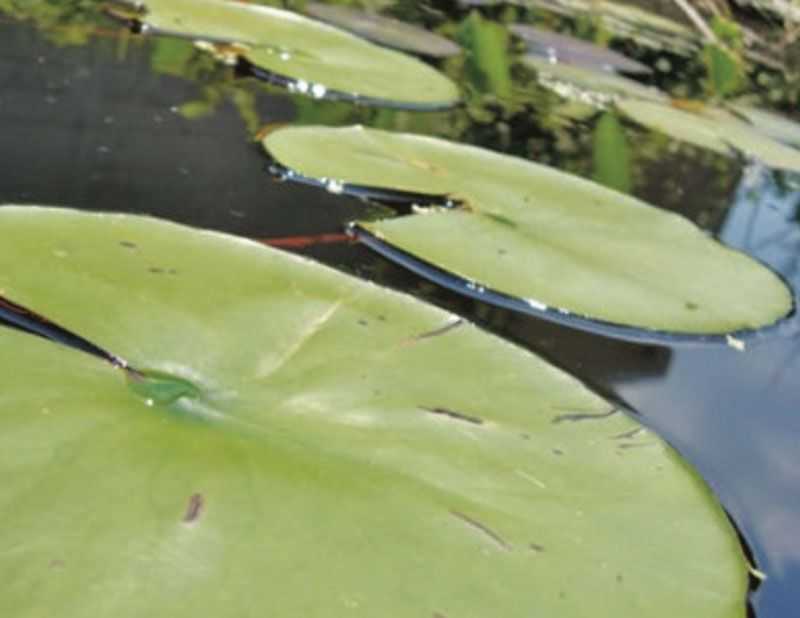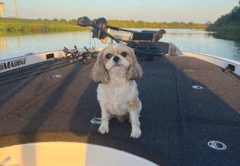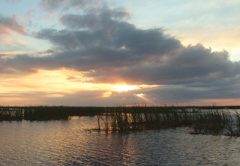For those of us fishing Lake Okeechobee, Lake Istokpoga, or any other south Florida lakes or waterway, to be successful in the summer-time means to have mastered the art of fishing the lily pads and the Floating Leaved Zone.
As we discussed in Article 1 of this series, aquatic plants can be divided into four zones, the Emergent Zone, the Floating Leaved Zone, the Submersed Zone, and the Free Floating Zone. This article will cover the Floating Leaved Zone with the lily pad being the most recognized plant within this zone.
As we move out and away from shore and into deeper water, we depart the Emergent Zone and enter the Floating Leaved Zone. Plants in this Zone are typically rooted in the lake’s bottom sediment and have leaves that float on the water’s surface. The leaves can vary in size from small silver dollar pads to large elephant ear sized leaves. To support the floating leaf, these plants have strong stems connecting the leaf to their root system and as one would expect, the bigger the leaf, the bigger and stronger the stem will be. Water lilies, spatterdock, American lotus, and Floating-hearts are species typically found within this category of plants.
DURING THE SUMMER MONTHS THE LARGE BROAD LEAVES OF THESE PLANTS PROVIDE SHADE FROM THE SUMMER SUN WHILE PRODUCING COOLER WATER TEMPERATURES AND HIGHER LEVELS OF OXYGEN.
Why are bass attracted to these areas, it’s simple, during the summer months the large broad leaves of these plants provide shade from the summer sun while producing cooler water temperatures and higher levels of oxygen. They also provide plenty of camouflage for a bass to hide and await its next meal.
Unfortunately fishing the lily pads isn’t for the faint of heart or those light in the pocketbook. Moving in and out of the pads can be tough work especially if you are going stealth and push poling your way into the pads. Pulling a 6-lbs plus bass out of these weeds takes serious manpower and stout tackle. Twenty dollar rod and reel combos aren’t going to make it here, you need rods with stiff backbones and reels that can handle 50#-braided line. Anything less and you’ll end up losing more fish than you bring onboard.
So let’s say you’re geared up and ready to fish the pads, on Lake Okeechobee, Lake Istokpoga, and similar lakes, there are a lot of pads to choose from and not all pads harbor fish, so where do you start. Like we discussed in previous articles, start by studying the lake’s structure. Look for natural channels into the pads, pads that stand-out lakeside of the main body, pads that are mixed with Emergent Zoned plants, pads at the mouth of creeks, culverts and points, and basically anything a bass can use as a highway in and out of the main stand of pads. For river fishing such as in the Caloosahatchee and Kissimmee rivers, any pad outside the channel is a change in structure and should be investigated.
Once you identified a promising area then stop, look, and listen to the pads. Seriously, look and listen to the environment. Since pads are in deeper water and if the conditions are favorable, bass, baitfish, and panfish will be moving underneath the pads. As they move, they’ll bump and brush up against the stems and root systems of the plants. When this happens, the movement transmits up the plant and makes the attached floating leaf move, so look for out-of-place movements within the lily field. If a bass is chasing it’s next meal, you’ll see the confrontation transmitted to the top of the lily pad. Generally the greater the movement is, the larger the fish will be. The next step is to listen to the pad field. If panfish such as sunfish or bluegills are there, you’ll hear popping sounds. These are sounds of fish feeding at the surface, and guess what, bass love to eat bluegills. The same is true for frogs and amphibians, they all emit or create some type of sound, whether they are calling for a mate, jumping from pad to pad, or being snatched up by Mr. Bass. So if the structure doesn’t look good and the environment isn’t teeming with life, move on to better fishing grounds.
So you’ve searched the pads and found a suitable environment, in general it’s the density of the pads that will determine which bait is best to use. If conditions allow, start fishing from the outside and work your way in. With areas adjacent to open water, start with a crank bait or spinner bait and work the open water outside the pads. If this doesn’t prove effective then perhaps try a weedless spinner bait on the edges of the pads. Most hairpin weedless spinner baits like the Okeechobee Special won’t foul up within this area. If that doesn’t produce any success, change to a weedless frog and start again from the weedline and work your way in. If you’re still bass-less, than change to a weighted worm, lizard, or creature bait and work the same areas and the open pockets within the pads. If the water is trending deeper, the bass may position themselves vertically within the water column. Therefore too little weight might not get the bait deep enough while too much weight may rocket the bait straight to the bottom and out of sight of the bass. Remember, much of the bite is reactionary, so cast in the same location multiple times. The first cast or two may just alert the bass to the presence of food and the next few casts allows him to track it down and pick it up. If all this fails, reposition your boat by a casts length and work the new area in the same manner.
As for coloration of your lures, non-aquatic critters have coloration patterns to protect themselves from predators from above such as birds, and bigger lizards, frogs, etc. Bass on the other hand are upward oriented and use this to their advantage and colors resembling the top of lily pads stand out to them. So under bright conditions choose hues of green and brown while under dark skies choose darker colored lures.
During the hot summer months, bass will tuck themselves into the shadowy recesses of the lilly pads. They will feed mostly during the early morning and late afternoon hours. However this doesn’t mean they are napping the rest of the day. During the off-hours they are still opportunistic feeders and will snatch up anything that is crawling, slithering, and hopping across the lily pads. So by skipping a plastic worm, lizard, or frog across the top of the pads, you’ll be creating noise and vibration that can really piss-off a slumbering bass and force him into an explosive strike.
As we mentioned earlier, fishing the pads is physical work, so getting the strike is only the beginning of the battle. Depending on your gear your options are quite limited. For the most part, a bass hooked in the pads will try to head deeper into the pads and try to free itself by utilizing the plant stems and root systems. So if you’re using light gear, you choice is to muscle the fish into open water as fast as you can and pray your line doesn’t break, or go chasing after it. There’s no time to be a sportsman and play the fish. In general the lighter your gear, the more time you’ll spend chasing. If you choose to go this route, give yourself a fighting chance and tie on some fluorocarbon leader. Make the leader long enough to be within hands reach when the fish is on the bottom. This way you’ll be grabbing onto leader and not your 10-lb test mono line. Need I mention that terminal tackle in the form of snaps and swivels is verboten (forbidden) here, it’s mono on mono or nothing at all.
Ideally it would be nice if the leader was longer than the water is deep, but this requires the knot to pass through the top eye of the rod. Unfortunately most rod manufacturers can’t grasp this concept and I’ve blown out the plastic guide ring on many a pole. I just replace it with something more suitable to my fishing habits. If you came prepared and have a shout rod and strong braided line, you should be forcefully evicting the bass from its home. Get his head above water and drag it and all the weeds that come with him onto your boat as fast as you can. If not, you’ll end up tangled in the weeds and you too will be chasing after the bass.
As you can see, fishing a stand of pads presents a lot of challenges, but the rewards are just as great. The only way to truly learn how to master the lily pads is by practice and time on the water. In and around Lake Okeechobee, going out with a seasoned guide is the best way to jump start your education for they have the gear, the knowledge, and the experience to set you on the right path to mastering the Floating Leaved Zone.








